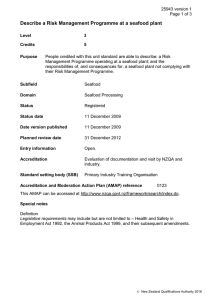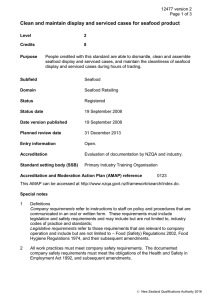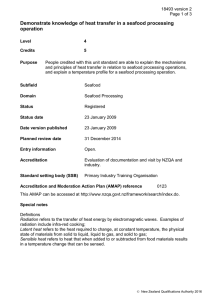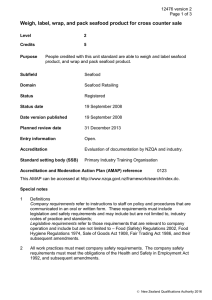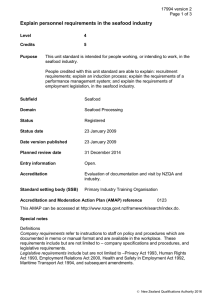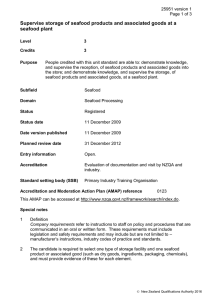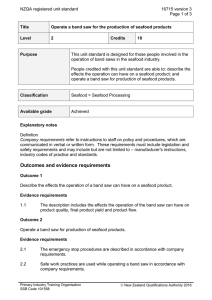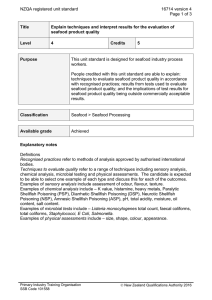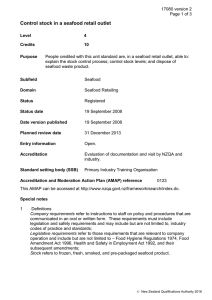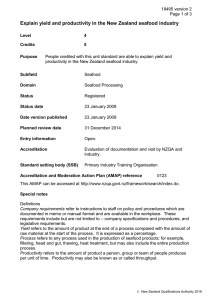16710 Write work instructions for a seafood processing task
advertisement
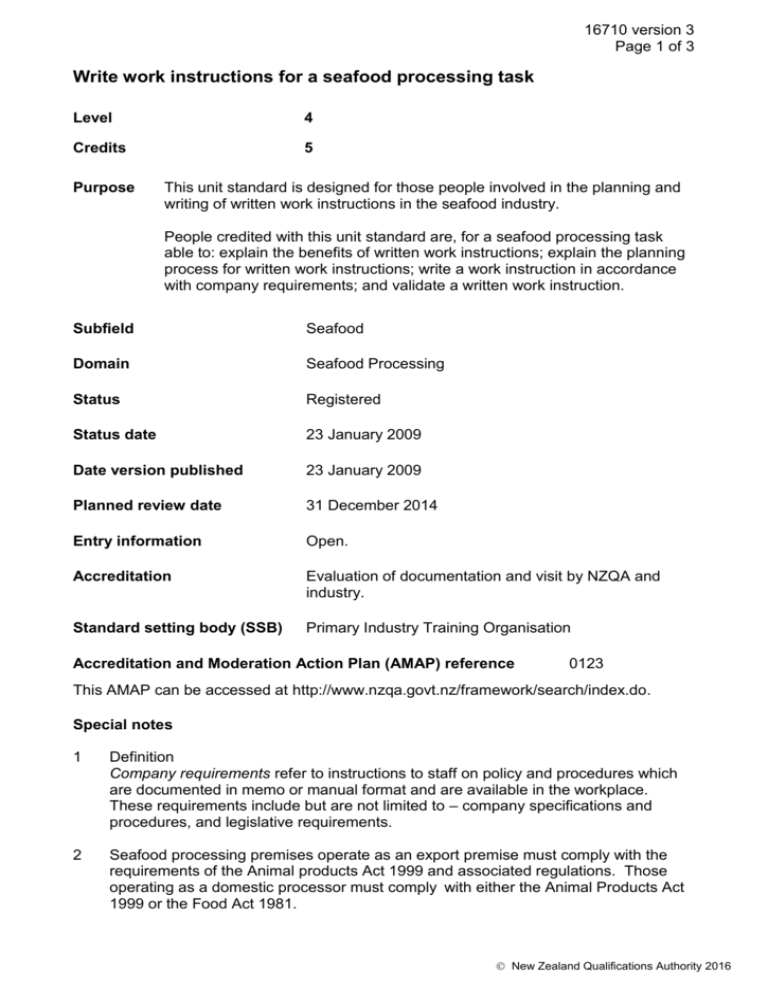
16710 version 3 Page 1 of 3 Write work instructions for a seafood processing task Level 4 Credits 5 Purpose This unit standard is designed for those people involved in the planning and writing of written work instructions in the seafood industry. People credited with this unit standard are, for a seafood processing task able to: explain the benefits of written work instructions; explain the planning process for written work instructions; write a work instruction in accordance with company requirements; and validate a written work instruction. Subfield Seafood Domain Seafood Processing Status Registered Status date 23 January 2009 Date version published 23 January 2009 Planned review date 31 December 2014 Entry information Open. Accreditation Evaluation of documentation and visit by NZQA and industry. Standard setting body (SSB) Primary Industry Training Organisation Accreditation and Moderation Action Plan (AMAP) reference 0123 This AMAP can be accessed at http://www.nzqa.govt.nz/framework/search/index.do. Special notes 1 Definition Company requirements refer to instructions to staff on policy and procedures which are documented in memo or manual format and are available in the workplace. These requirements include but are not limited to – company specifications and procedures, and legislative requirements. 2 Seafood processing premises operate as an export premise must comply with the requirements of the Animal products Act 1999 and associated regulations. Those operating as a domestic processor must comply with either the Animal Products Act 1999 or the Food Act 1981. New Zealand Qualifications Authority 2016 16710 version 3 Page 2 of 3 Elements and performance criteria Element 1 Explain the benefits of written work instructions for a seafood processing task. Performance criteria 1.1 The explanation outlines the benefits to the company of written work instructions. Range 1.2 evidence is required for three benefits. The explanation outlines the benefits to the employee of written work instructions. Range evidence is required for two benefits. Element 2 Explain the planning process for written work instructions for a seafood processing task. Performance criteria 2.1 The explanation includes the steps required to write the work instruction in accordance with company requirements. Range 2.2 steps may include are not limited to – preparation, gathering evidence, drafting, consultation, issue, validate. The explanation includes the sources of information that can be used to develop written work instructions. Range sources of information include but is not limited to – legislation, industry standards; evidence is required for four sources. Element 3 Write a work instruction for a seafood processing task in accordance with company requirements. Performance criteria 3.1 The work instruction outlines the sequential steps required to complete the task. 3.2 The work instruction identifies the key task roles and responsibilities of the person performing the task. 3.3 Format, language and content requirements of the work instruction are met. New Zealand Qualifications Authority 2016 16710 version 3 Page 3 of 3 3.4 Corrective actions associated with the task are included in the work instruction. 3.5 Safe work practices and hygienic requirements that relate specifically to the task are identified. Element 4 Validate a written work instruction for a seafood processing task. Performance criteria 4.1 The written work instruction is consistent with the task. 4.2 The written work instruction is validated as being in accordance with company requirements. Please note Providers must be accredited by NZQA, or an inter-institutional body with delegated authority for quality assurance, before they can report credits from assessment against unit standards or deliver courses of study leading to that assessment. Industry Training Organisations must be accredited by NZQA before they can register credits from assessment against unit standards. Accredited providers and Industry Training Organisations assessing against unit standards must engage with the moderation system that applies to those standards. Accreditation requirements and an outline of the moderation system that applies to this standard are outlined in the Accreditation and Moderation Action Plan (AMAP). The AMAP also includes useful information about special requirements for organisations wishing to develop education and training programmes, such as minimum qualifications for tutors and assessors, and special resource requirements. Comments on this unit standard Please contact the Primary Industry Training Organisation standards@primaryito.ac.nz if you wish to suggest changes to the content of this unit standard. New Zealand Qualifications Authority 2016

